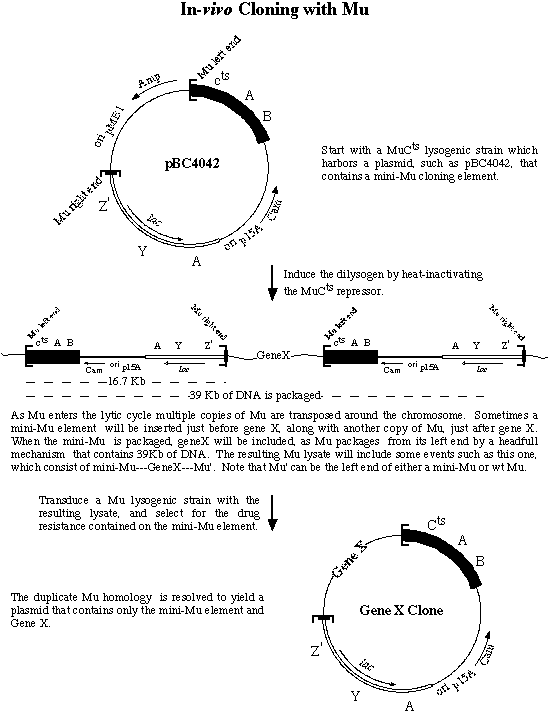
The mini-Mu in-vivo cloning system of Groisman and Casadaban utilizes mini-Mu elements ranging in size from 7.9 - 21.7 Kb to clone chromosomal inserts of 7 - 31.1 Kb. Most of the mini-Mu elements contain part of the left end of Mu (ctsAB), a drug resistance and plasmid origin, a truncated lac'ZYA operon for making lac operon fusions, followed by 117 bp of the right end of Mu. The smallest mini-Mu element (MudI5005) lacks the lac'ZYA operon, and although it can not be used to make lac operon fusions, it does allow for cloning very large pieces (up to 31.1 Kb) of chromosomal DNA. First, a plasmid containing a mini-Mu element is introduced into a Mucts lysogenic strain that contains the gene of interest to be cloned. Next, this dilysogen is induced by heat-inactivating the Mucts repressor. As Mu enters its replicative cycle, multiple copies of Mu are transposed around the chromosome. Some of these events will generate a mini-Mu element that is inserted just before the gene of interest, followed closely by another copy of either a mini-Mu or a full length Mu. Mu is packaged by a headfull mechanism that incorporates 39 Kb of DNA starting with the left end of Mu. Since all of the mini-Mu elements are less than 39 Kb in length the packaging reaction will include chromosomal DNA. If another direct repeat of Mu is present within the 39 Kb packaging endpoint a mini-Mu---Gene X----Mu' containing piece of DNA will have been packaged. By transducing the resulting lysate into a recipient that contains Mu repressor, and selecting for the drug contained on the mini-Mu element, the duplicate Mu homology is resolved, and a plasmid is formed that contains only gene X and the mini-Mu element. The chromosomal piece of DNA containing gene X can then be subcloned into another plasmid vector for further study.
Salmonella Tricks
Wild type Mu will not infect Salmonella. However, a Mu-P1 hybrid phage that contains the P1 tail genes instead of the Mu tail genes will infect a Salmonella galE strain
grown in .2% glucose to repress the gal genes. So to use the mini-Mu cloning system in Salmonella the plasmid containing the mini-Mu element is transformed into a MuhP1 (Mu Cts62 hP1-1) lysogenic galE Salmonella strain. The resulting lysate must then be transduced into a galE Salmonella strain that contains Mu repressor.
References
1- Groisman, E. A., Castilho, B. A., and Casadaban, M. J., 1984. Proc. Natl. Acad. Sci. 81, 1480-1483. This is the first paper and it describes pBC4042, the parental mini-Mu element contained on a plasmid.
2- Groisman, E. A., and Casadaban, M. J., 1986. J. Bact. 168, 357-364. This paper describes the rest of the mini-Mu cloning elements available on plasmids.
3- Groisman, E. A., and Casadaban, M. J., 1987. J.Bact. 169, 687-693. This paper describes the use of the in-vivo cloning system to clone genes from various enteric bacteria, including Salmonella.
Last Update: Thursday June 19 2014
This page has been viewed Failed to execute CGI : Win32 Error Code = 2
times.
Eric Kofoid
eckofoid at ucdavis.edu